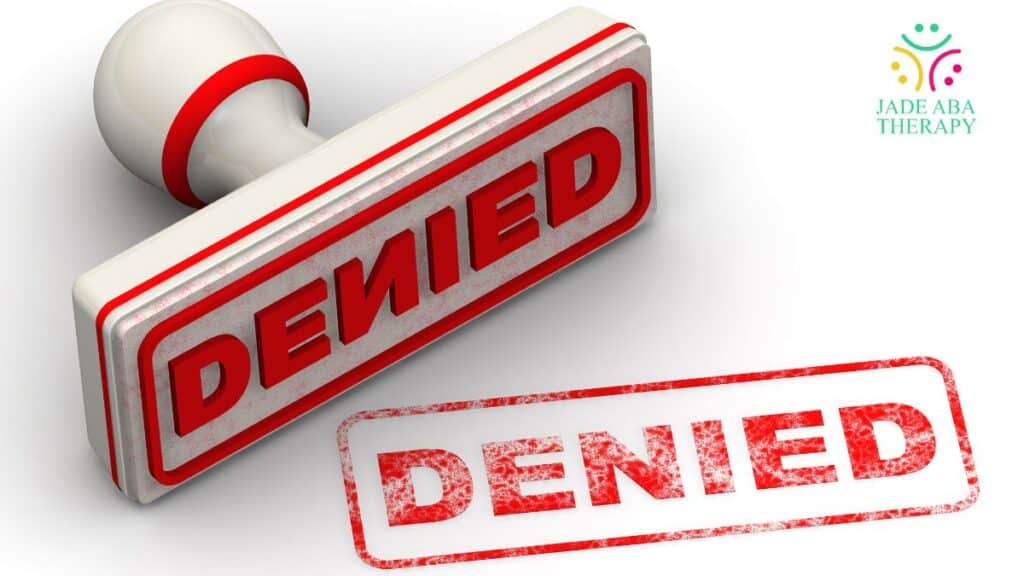Key Points:
- Successfully appeal denied ABA hours by matching the denial reason to medical necessity evidence and meeting all deadlines.
- Strengthen your case with a clear treatment plan, outcome-linked progress data, and clinician letters that directly answer the insurer’s criteria.
- Request external review if internal appeal fails and cite parity rules where applicable.
Denial letters cut hours, routines stall, and progress feels at risk. “Appeal denied ABA hours” means taking the insurer’s reason, matching it to proof of medical necessity, and asking for the right fix on record.
In the next sections, families get plain steps and timelines to turn a “no” into the level of care a BCBA recommends. Let’s flip that letter from a stop sign into a plan of action.

Why Does an ABA Denial Happen in the First Place?
Health plans deny ABA requests for a few common reasons. These include:
- Missing prior authorization
- Lack of medical necessity
- Service limits
- Coding errors
- Out-of-network issues.
- Documentation does not match billed codes
The path to overturning a denial starts with naming the exact denial category in your letter and responding with the right proof.
One national review found marketplace insurers denied about 17% of in-network claims in 2021, yet consumers appealed fewer than 0.2% of those denials and plans upheld most first-level appeals. The low appeal rate shows many families never push back even when they could.
What to check first
- Denial letter: Note the reason, policy citations, and appeal window. Many common questions are clarified in an ABA therapy FAQ.
- Plan documents: Read the plan’s clinical policy for ABA, prior authorization rules, and any session caps, including practical guidance on insurance coverage for ABA therapy.
- Records: Gather the BCBA assessment, treatment plan, progress notes, and caregiver training logs that align with the denied codes or hours.

Step 1: Request and Review Everything: Denial File, Policies, and Call Logs
Appeal denied ABA hours effectively by obtaining the full administrative record. Ask the plan for the following:
- Internal clinical guidelines used to deny
- Notes from utilization review
- Any peer review report
Under federal rules and many state laws, you can request these materials during an appeal.
Build a quick evidence file
- BCBA evaluation: Include diagnostic basis, baseline skill levels, and functional assessment data.
- Treatment plan: Spell out target behaviors, task analyses, session structure, parent training goals, and safety plan.
- Progress data: Show graphed trends, generalization across settings, and response to prior hours.
- Medical necessity letter: Have the BCBA or supervising clinician tie each requested hour block to specific goals and risks of delay.
Pro tip: If the denial cites “insufficient documentation,” fix alignment, not volume. Label exhibits to mirror the plan’s criteria and cite page numbers in your appeal letter so the reviewer sees the match.
Step 2: Prove Medical Necessity With Clear Aba Outcomes and Risks
The next thing to do is to translate data into conclusions a medical reviewer can follow. Use short paragraphs that tie each requested hour category to a measurable outcome and time-bound milestone.
What strong medical necessity looks like
- Functional need: Link each hour type (e.g., 1:1, parent training, supervision) to specific deficits and unsafe behaviors.
- Intensity rationale: Cite evidence that intensity changes outcome probabilities for your learner profile; then show how your child’s trend lines support the dose you seek.
- Risk if under-treated: Explain regression or safety incidents that occur when hours were cut.
- Least restrictive logic: Show that requested ABA, such as home-based ABA therapy, avoids more invasive or higher-cost care (ER visits, out-of-home placement).
Use the plan’s language back at it
- Mirror the plan’s own definition of medical necessity line by line.
- Quote the plan’s ABA policy (criteria, outcome expectations, supervision ratios) and note where your records satisfy each point.
- If the plan’s policy conflicts with generally accepted standards or mental health parity rules, call out the inconsistency and ask for reconsideration.

Step 3: Meet Every Appeal Deadline and Escalate on Time
Insurers set strict windows. Many employer plans governed by federal law must give at least 180 days to file an internal appeal after an adverse determination. Mark two additional dates: when the plan must answer your appeal and when you can request external review.
Practical timeline playbook
- Day 0–10: Request the full denial file, policies, and reviewer credentials.
- Day 10–30: Compile the appeal packet with exhibits and a concise cover letter.
- Day 30–45: Submit the appeal by tracked delivery and portal upload.
- After the decision: If upheld, request peer-to-peer (if offered) and prepare an external review if eligible.
If the issue is urgent
- Ask for an expedited appeal based on risk of serious harm or loss of function.
- If the plan refuses to expedite, state the clinical reasons in writing and proceed to the next level allowed.
Step 4: Use Peer-To-Peer Reviews and Targeted Letters From Your BCBA
A peer-to-peer allows your BCBA or supervising clinician to explain why the requested hours meet standards. Prepare with a tight script:
Peer-to-peer essentials
- Opening: Diagnosis, severity indicators, and safety history.
- Data snapshot: Baseline, progress since last authorization, barriers that drive intensity.
- Hour logic: Why 20 vs. 10, or 30 vs. 20, where parental training hours prevent regression.
- Fallback plan: Offer a trial authorization with criteria for continuation if the reviewer hesitates.
Clinician letters that work
- Put the medical necessity conclusion in the first paragraph.
- Tie each hour block to goals, safety, and expected weekly gains.
- Attach a short appendix mapping plan criteria to evidence in your packet.
Step 5: Request External Review if Internal Appeal Fails
If your internal appeal is denied, you may qualify for an independent external review. Federal rules set maximum decision times of 45 days for a standard external review and 72 hours for expedited cases.
How to prepare for an external review
- Reframe the dispute: Focus on evidence of medical necessity and parity concerns, not billing arguments.
- Tighten exhibits: Remove duplicates, add a one-page index, and lead with the strongest data.
- Ask for rule-specific relief: Cite the plan’s duty to apply generally accepted standards for autism treatment and to avoid non-quantitative limits that hit behavioral health more harshly.
External review uses an independent reviewer who applies clinical criteria to the medical facts. Many families see reversals here, especially when documentation is strong and timelines are met.
Step 6: Leverage Success Data and Keep Appealing When Odds Improve
While families rarely appeal denied ABA hours, success rates can be high once an appeal is filed. For example, in Medicare Advantage, only about 10% of denials were appealed in 2022, but 83% of appealed denials were overturned.
What this means for ABA families
- Filing the appeal may be the biggest hurdle.
- Well-organized medical necessity arguments change outcomes.
- If your first appeal fails, external review can still resolve the dispute.
Step 7: Prevent Repeat Denials: Authorization, Coding, and Parent Training Logs
Appeal denied ABA hours today to prevent ABA rejected requests tomorrow. Many denials stem from process issues as much as clinical disagreements. Tighten the front end.
Pre-authorization and coding
- Authorization checklist: Confirm CPT codes, modifiers, place of service, and start/stop dates.
- Coding alignment: Match progress notes and supervision minutes to billed units.
- Session notes: Use clear, consistent language that mirrors goals and interventions.
Parent and caregiver documentation
- Log caregiver training participation and at-home practice.
- Track generalization across settings and people.
- Document safety plans and incident reductions tied to caregiver training hours.
Parity and plan policy reviews
- Save screenshots or PDFs of plan policies used in denials.
- Compare behavioral health limits to medical/surgical standards.
- Flag non-quantitative treatment limits that appear stricter for ABA.
Appeal Denied ABA Hours: Build a Winning Packet
When filing for an appeal, assemble a packet that answers “why these hours, for this child, right now.” Keep it readable. Put the conclusion upfront, then show proof.
Packet structure that reviewers appreciate
- Cover letter (1–2 pages): State the request, the denial rationale, and the medical necessity case in plain language.
- Clinical exhibits: BCBA assessment, treatment plan excerpts, progress graphs, behavior incident logs, and caregiver training logs.
- Policy mapping: A one-page grid aligning plan criteria with your evidence.
- Professional support: Letters from pediatrics, speech, or OT that explain why ABA intensity supports broader health and safety goals.
- Risk statement: Concise explanation of harm from reduced hours and how the requested hours prevent higher-cost care.
In your cover letter, explain the purpose of submission and again when you summarize the exact relief sought and the reasons it meets the plan’s own standards.

Step 8: Handle Special Scenarios: Partial Approvals, Retro Denials, and Transition Periods
Sometimes the plan approves some hours and denies the rest. Sometimes previously paid claims get reprocessed and denied. Address each scenario cleanly.
Partial approvals
- Accept the partial approval to protect ongoing care but continue the appeal for the remainder.
- Request a trial increase with defined metrics for continuation if the reviewer is on the fence.
Retro denials
- Ask for the audit rationale and claim adjudication notes.
- Resubmit corrected claims with clarifying documentation and a short memo that cites the original authorization or medical necessity.
Transitions
- When changing plans or moving from early intervention to school age, align care with your student’s IEP goals for autism and submit a continuity-of-care request if available under your plan and state law.
- Include a clear handoff plan and updated goals so hours do not lapse.
Write a Persuasive Appeal Letter (Template You Can Adapt)
Opening paragraph: “We appeal denied ABA hours for [Child, DOB] based on medical necessity and plan criteria. We request authorization of [X] hours per week of 97153, [Y] hours of 97155, [Z] hours of caregiver training 97156, and [S] hours of supervision 97155/97158 for [duration].”
Body paragraphs:
- Clinical summary: Diagnosis, severity, functional risks, and current goals.
- Outcome data: Two or three short examples of skill gains tied to current or past intensity.
- Dose rationale: Why the requested mix of codes and hours is essential to achieve time-bound goals.
- Policy mapping: Line-by-line match to the plan’s criteria.
- Risk of delay: What happens when hours are cut, with references to incidents or regressions.
Closing paragraph: “Based on the evidence attached and the plan’s standards, we request reversal of the denial and full authorization as specified above. If the plan maintains the denial, we request a peer-to-peer review and written notice of external review rights.”
Frequently Asked Questions
How many times can you appeal an insurance denial?
You can appeal an insurance denial at least once internally, with many plans offering multiple levels. After completing internal appeals, most non-grandfathered plans must provide access to an external review for eligible medical denials. Employer plans must allow at least 180 days from the denial date to file the internal appeal.
Why would insurance deny ABA therapy?
Insurance denies ABA therapy when prior authorization is missing, documentation lacks medical necessity, codes or modifiers are incorrect, plan limits are exceeded, or services are out-of-network. Some denials reflect review standards misaligned with accepted ABA practice. Successful appeals directly address the denial reason using the plan’s criteria.
Why do insurance appeals take so long?
Insurance appeals take time due to internal review processes, peer evaluations, and record requests. External review adds further delay through independent evaluation. Federal rules allow 45 days for standard and 72 hours for urgent external reviews, excluding preparation time and correspondence. Fast, complete responses help reduce delays.
Get More ABA Hours Approved: Start Your Appeal Today
Families in Maryland and Virginia can access reliable in-home ABA therapy. At Jade ABA Therapy, our team builds treatment plans that translate into approvals, pairs progress graphs with outcome goals, and supports you through internal and external reviews.
We focus on clear medical necessity, clean documentation, and caregiver training that shows real-world gains, which strengthens appeals and protects approved hours. Many denials change when strong data and deadlines meet the reviewer’s checklist.
If you need help turning a denial into the right level of care for your child, reach out to our team. One conversation sets up a plan, a record set, and timelines that keep services on track.




